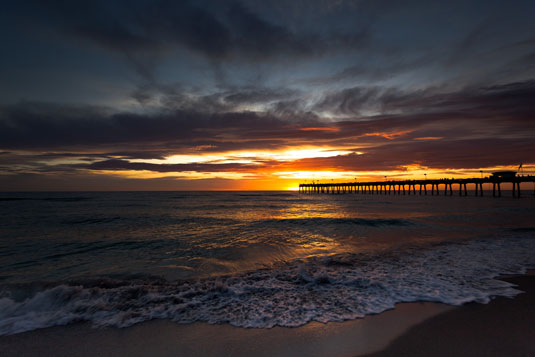Sunset gives you the same wonderful light for photographs you get in the morning, only you get the wonderful light at the end of the day, then the sun dips below the horizon and any clouds in the area are bathed with giddy hues of orange, pink, and purple. Sunrise and sunset are the proverbial bookends of a day — hopefully, a day filled with photographic adventures.
At sunset, you have about 75 minutes of beautiful light for photography. To have as much time as possible for the actual shoot, do your preparations ahead of time:
Know the exact time the sun sets and when it will stop shining on the landscape. Find out what time the sun sets by performing an Internet search or watching the weather section of your local broadcast news.
If you’re photographing in the mountains and you’re below the peaks, the sun stops illuminating the landscape before it actually sinks below the horizon. The distance below the peak behind which the sun sets determines when the area you’re in will be in shadow.
If you’re shooting in a forest, the sun dips below the highest trees a few minutes before it sinks below the horizon. You can get dramatic shots of the sun shining through the trees. You’ll have long shadows as well.
Several programs are available that can calculate when the sunset will occur and when the sun will stop shining. One is called The Photographer’s Ephemeris. It’s a free desktop application, or you can purchase an application for a mobile device.
Choose a great landscape for your sunset shot. Pick a landscape with character. Beaches are great spots to shoot sunsets, but any landscape can be a good location. You’ll need interesting elements in the location to draw your viewers in.
Choose the right location. You can go to the most beautiful location in the world and still not get a great photograph. Moving to a different vantage point can make all the difference between a great picture and an average picture. This is where your knowledge of the area or your research of an area you’re going to visit will come into play.
Shoot your sunset on a day when clouds are in the sky. If you photograph the sunset in a place where you live, you’ll know the weather patterns and can predict whether you’ll have the ingredients for a great sunset picture.
Ansel Adams could predict if it would be worth photographing the sunset in Yosemite by looking west half an hour before sunset. You need to become that intimate with the landscape where you live.
Use water features to enhance your picture. If you’re photographing a location where the sun sets over a lake or the ocean, the sun will cast wonderful reflections. If the water is choppy, the pattern of the waves catches the reflections. If the water is like glass, you capture an image with a wonderful swatch of golden color.
Compose your image properly. Placing the sun in the center of the image results in a boring photograph. Instead, compose the picture so that the sun is on the left or right side of the image about one-third of the way from the edge.
The placement of the horizon line depends on the scenery. If you have a mundane landscape with a wonderful layer of clouds, place the horizon line in the lower third of the image. If you’re photographing the sun setting over a mountain range, place the horizon line in the upper third of the image.


